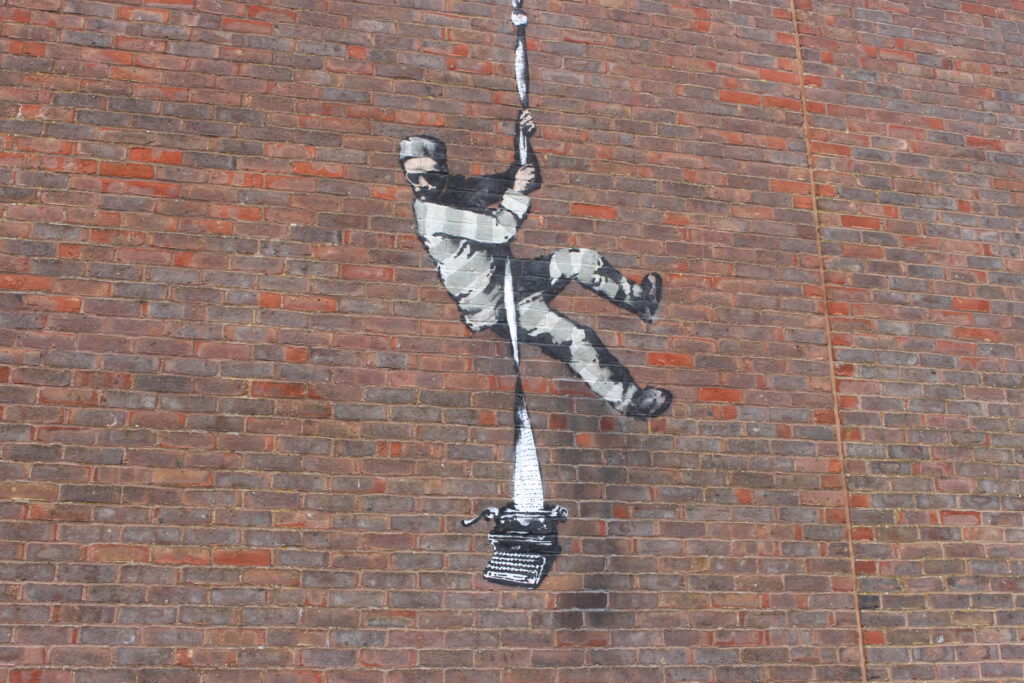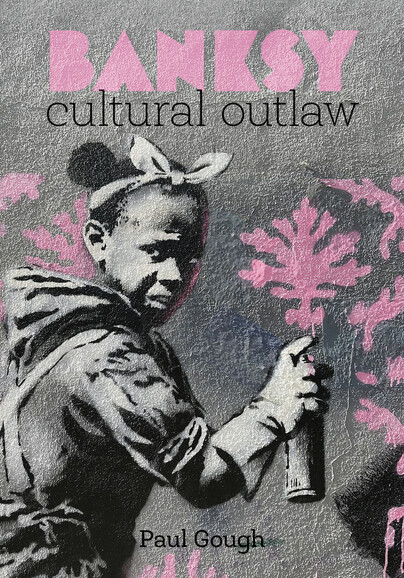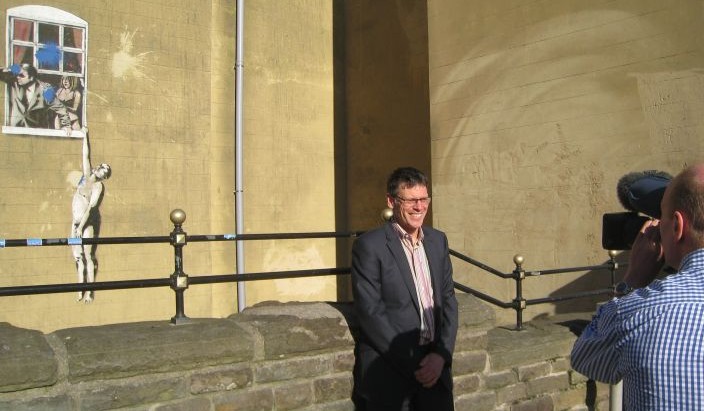Banksy has often been discussed more for his identity than his ideas but Paul Gough — artist, academic, and Banksy commentator — offers a new perspective. Drawing on decades of observation, media commentary, and even direct correspondence with Banksy’s team, Gough explores the artist’s creative evolution, political voice, and cultural influence. We spoke to Paul about what inspired this fresh take and why it’s time to stop asking “Who is Banksy?” and start asking “What is Banksy saying?”
There’s been a lot of commentary on Banksy and his work. What makes Banksy: Cultural Outlaw different?
I wanted to focus on Banksy as an artist, as a practicing painter but also his activity as a curator, writer and filmmaker. Instead of becoming fixated on his identity, or the price of his artworks, which is so often the case, let’s look at how he’s revolutionised the way that stencils are used, how he’s employed ‘brandalism’ to create his iconic images, and how he’s managed to stay edgy and relevant.
You’ve said this book moves past the “who is Banksy?” question. Why was it important to shift the focus away from his identity and toward his art?
I chose to do so in the book because we’ve stopped asking ourselves about the actual pictorial meaning of the work itself – I mean why choose a motif such as a lighthouse or the Madonna, or a dozen other iconic images. For all the humour, Banksy is an artist of great intent: he chooses his subjects carefully, they are always placed and positioned with great deliberation, and his timing is achieved with great exactitude.

Credit: Photographs all author’s own
You examine his art in detail — is there one that, for you, that best encapsulates Banksy’s artistic voice?
That’s a difficult question to answer as his work covers such a range: some of the larger pieces like the great escape from Reading Gaol are evidence of a high level of drawing and painting; others like the bicycle piece Hula Hoop Girl in Nottingham re exquisite in terms of their position, timing and location. One of two of the recent film – London underground’s deep clean- produced at the height of Covid combine wit and edge in the most compelling fashion.
The book also explores Banksy’s role as a curator and filmmaker. What do these lesser-known sides of him reveal about his art and his cultural impact?
Unlike many artists, Banksy is a natural collaborator; he can animate a large team, catalysing the energy of others to produce grand spectacles – such as Dismaland – and he appears to work really well with film makers. Increasingly the films are vital to the power of the stencils; they reveal the craft and the craftiness behind some of the stunts. Like his mockumentaries they are proof of his ability to create engaging narratives that are tightly shot and incisively edited. Being nominated for an Oscar was no fluke.
You had direct correspondence with Banksy’s team during his 2009 Bristol show. What was that experience like — and did it shape how you approached this new book?
It was both energising and frustrating. Clearly Banksy’s people – Pest Control Office – wanted to appear supportive, but on their terms, which is only right and proper. At the time they stuck to their guns on some issues, but gave way on others. At all times we remained mutually respectful and as open as we could be given the unusual context of Banksy’s art and anonymity. On reflection though I’m so glad we persisted and that the dialogue proved genuinely constructive.
Do you think Banksy’s work still carries the same disruptive power in today’s highly commercialized art world?
It still has the power to disrupt daily lives
and evoke a mass response; just witness the tens of thousands of comments on
his social media when a new piece is revealed. So clearly it touches nerves, it
arouses passions, and unleashed a powerful reaction. Whether it – or for that
matter any art – can genuinely shift the political or social dial is
questionable, but Banksy’s political work adds to the body of evidence that
values fair play, liberty and justice. After all how many other artists have
created and funded a boat to rescue migrants on the high seas?

Banksy | Script Books
Your book touches on themes of urbanism, activism, and deindustrialization. How do these broader cultural forces frame Banksy’s work in a different light?
They remain the core themes of his art; the context for his practice laced invariably with an edgy wit and some of the best one-liners in the art business. It’s what made writing this book such a fascinating project but also great fun.
What’s one surprising thing you uncovered during your research that you think most people don’t know about Banksy?
Several things: how much money he gives away through charitable acts. His disdain for the art market and the audacious on-sales and mark-up on prices dictated by auction houses. His initial reluctance and then recognition that his print studio needed to be professional, reputable and reliable, so as to avoid counterfeits and dodgy practices. Above all, a sense of outrage at the wrongs in the world and his ambition for art to address them.
Now available for pre-order: Banksy: Cultural Outlaw: Banksy | Script Books
Paul Gough’s Banksy: Cultural Outlaw offers a rare perspective on a figure who’s often reduced to mystery and media spectacle. Whether you’re a long-time fan or looking to see Banksy with fresh eyes, this book is a bold invitation to look beyond the Banksy’s identity and into his message.

 Follow
Follow